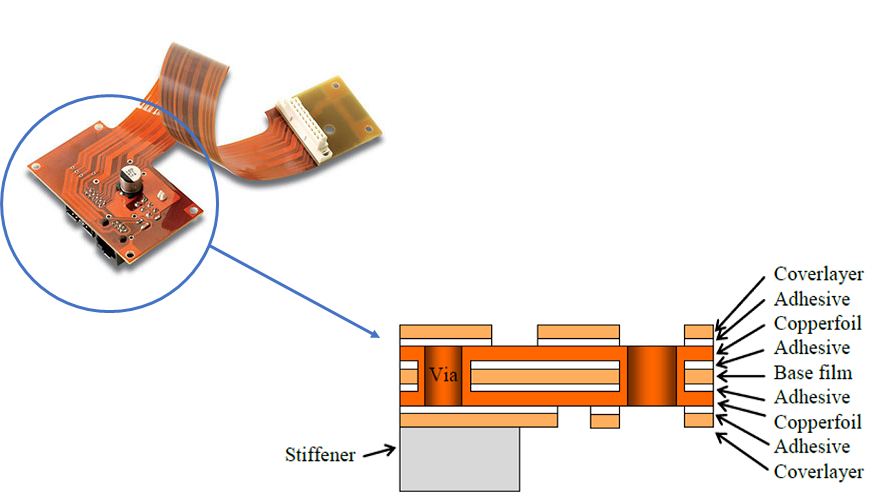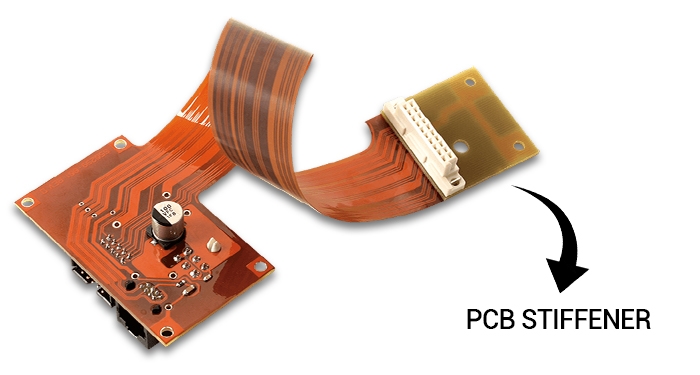Flex circuits, also known as flexible printed circuit boards (FPCBs), are electronic components crafted from flexible materials like polyimide or polyester. Their pliability allows them to adapt to diverse shapes and spaces, making them indispensable in the medical, aerospace, and consumer electronics sectors. Best FPC, a prominent exporter in the flex PCB industry, excels in the rapid manufacturing of these vital components. Renowned for their reliability and durability, our products deliver peak performance, meeting the stringent requirements of instrumentation, industrial settings, and beyond.

Understanding Flex Circuit Stiffeners
Definition and Purpose of Flex Circuit Stiffeners
Flex circuit stiffeners are integral components added to flexible printed circuit boards (FPCBs) to bolster rigidity in specific areas. They play a crucial role in providing additional support where connectors are affixed or where heightened mechanical stability is required. By reinforcing the flex circuit, stiffeners safeguard the integrity of electrical connections while preserving flexibility in other parts of the circuit.
Types of Stiffeners: Materials and Configurations
Stiffeners come in diverse materials, each offering varying levels of rigidity and flexibility. Common materials include polyimide, FR4 (a flame-retardant fiberglass), and metals such as stainless steel. Best FPC offers Multilayer Flexible Circuits Stiffeners in configurations such as Polyimide (0.075-0.20mm), FR4 (0.15-2.0mm), and punched or formed metal parts, tailored to meet specific application requirements and environmental conditions.
Role in Enhancing Mechanical Support and Stability
The primary function of stiffeners in flex circuits is to bolster mechanical support and stability, particularly in high-stress areas or where components are mounted. Stiffeners effectively distribute stress evenly across the circuit, mitigating damage and ensuring consistent performance throughout the operational lifespan of the flex circuit.
Benefits of Flex Circuit Stiffeners
Improved Bending Endurance and Reliability
Flex circuit stiffeners significantly enhance bending endurance, protecting the circuit from fatigue and breakage caused by repetitive bending. This improvement boosts the overall reliability and durability of the flex circuit, making it ideal for dynamic applications where frequent flexing is required.
Protection Against Mechanical Stress and Strain
Stiffeners provide essential protection against mechanical stress and strain, shielding vulnerable areas of the flex circuit from external forces that could potentially cause physical damage. This safeguarding capability is invaluable in harsh environments or applications subject to frequent handling or vibration.
Facilitation of Component Mounting and Assembly
Another key advantage of stiffeners is their role in simplifying component mounting and assembly processes. By providing a stable foundation, stiffeners enable secure attachment of components such as connectors, switches, and other electronic elements. This enhanced rigidity streamlines manufacturing and assembly procedures, reducing the risk of damage and ensuring reliable electrical contacts throughout the circuit's lifespan.
Design Considerations
Factors Influencing Stiffener Selection
Selecting the appropriate stiffener for a flex circuit involves evaluating several factors, including environmental conditions, mechanical requirements, and cost considerations. Environmental factors such as temperature and humidity dictate the choice of materials for optimal durability and performance. Mechanical needs, like the requirement for flexibility or rigidity in specific areas, determine the type and thickness of stiffeners used. Cost considerations are essential for balancing budget constraints with the performance demands of the application.
Integration with Overall PCB Design Process
Integrating stiffeners seamlessly into the flex PCB design process is critical. Designers must ensure that stiffeners enhance mechanical stability without compromising the inherent flexibility of flex circuits. Strategic placement and secure attachment of stiffeners during the design phase are crucial to maintaining overall circuit functionality and integrity.
Impact on Flexibility, Thickness, and Weight of Flex Circuits
Incorporating stiffeners into flex circuits influences their flexibility, thickness, and weight. While stiffeners typically increase overall thickness and may add weight, their proper design and integration preserve circuit flexibility where needed. This balance allows flex circuits to maintain their ability to bend and conform to complex shapes, essential for diverse applications requiring both durability and adaptability.

Application Examples
Cases Illustrating Effective Use of Stiffeners in Various Industries
Stiffeners play a pivotal role across industries such as aerospace, medical devices, and consumer electronics, enhancing the functionality and longevity of flex circuits. In aerospace, stiffeners support stringent reliability requirements amidst harsh environmental conditions. Medical devices benefit from stiffeners that maintain precision in compact designs while ensuring compatibility with sterilization processes. Consumer electronics utilize stiffeners to achieve durable, flexible designs suitable for compact devices subjected to daily use.
Specific Challenges and Solutions Implemented
Each industry presents unique challenges addressed through tailored stiffener solutions. Aerospace applications contend with vibration and extreme temperatures, necessitating stiffeners to maintain circuit stability under stress. Medical devices require bio-compatible materials and precise configurations to meet regulatory standards and operational demands. In consumer electronics, balancing flexibility with durability involves selecting stiffener materials and configurations that withstand mechanical wear while preserving circuit integrity.
Future Trends and Innovations
Emerging Technologies in Flex Circuit Stiffeners
Future innovations in flex circuit stiffeners focus on enhancing performance while reducing weight and maintaining flexibility. Developments in lighter composite materials and nano-material integration push the boundaries of design possibilities for flex circuits, catering to evolving industry demands for high-performance, adaptable electronics.
Potential Advancements in Materials and Manufacturing Techniques
Anticipated advancements include the development of advanced materials offering superior performance at reduced costs and environmental impact. Innovations in manufacturing, such as additive manufacturing techniques like 3D printing, promise to revolutionize stiffener integration by enabling complex and precise configurations in flex circuits.
Impact on Next-Generation PCB Designs
The evolution of stiffener technologies is poised to revolutionize next-generation PCB designs. Future advancements will enable thinner, lighter, and more flexible circuits capable of meeting the stringent demands of emerging applications in wearable technology, implantable medical devices, and beyond. Enhanced stiffeners will empower designers to create robust electronics capable of operating reliably in diverse and challenging environments, expanding the scope of what flex circuits can achieve in modern electronics.
CONCLUSION
The strategic integration of stiffeners in flexible printed circuit boards (FPCBs) plays a vital role in enhancing their mechanical stability, reliability, and performance across diverse industries such as aerospace, medical devices, and consumer electronics. Stiffeners ensure that flex circuits meet rigorous application requirements by providing essential support. With ongoing advancements in stiffener materials and manufacturing techniques, FPCBs are poised to become lighter, more flexible, and more durable, capable of withstanding challenging environments and adapting to innovative uses. The continuous evolution and incorporation of stiffener technologies are pivotal in expanding the capabilities of flex circuits, underscoring their crucial role in shaping the future of electronic design and functionality.










 2024-06-19
2024-06-19
 BEST
BEST

.png)
.png)
.png)
.png)

.png)

